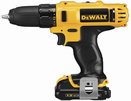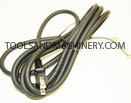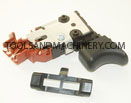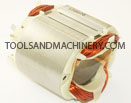Diagnosing Parts for Power Tool Repair
To better understand how to diagnose your power tools, it is important to first know how they work. Although your tools and their motors can be intensely complex machines, becoming familiar with the basic functions and pieces of your tool’s motor is not only important but surprisingly simple as well.
 Firstly, your power tool receives and delivers power just like water moves through a series of pipes, out of your sprinkler heads, and then onto your lawn or garden. If said water doesn’t come sparkling from your sprinklers to the earth, you can sure be a problem has occurred somewhere along its path of movement. In theory, problems in your power tools occur, and can be diagnosed, in exactly the same way. Electricity follows a distinct path in your power tools; it enters from a power source and travels along an electrical path of wires and connectors to the tool’s motor where it is converted into actual physical power. That power is then expelled at the opposite end of the tool in the form of a spinning chuck or saw blade.
Firstly, your power tool receives and delivers power just like water moves through a series of pipes, out of your sprinkler heads, and then onto your lawn or garden. If said water doesn’t come sparkling from your sprinklers to the earth, you can sure be a problem has occurred somewhere along its path of movement. In theory, problems in your power tools occur, and can be diagnosed, in exactly the same way. Electricity follows a distinct path in your power tools; it enters from a power source and travels along an electrical path of wires and connectors to the tool’s motor where it is converted into actual physical power. That power is then expelled at the opposite end of the tool in the form of a spinning chuck or saw blade.
The electrical path begins, of course, with a power source like a battery or power cord. Once this source is activated electrical energy travels through the power cord to the tool’s switch or trigger which will either make or break the electrical flow that powers your tool. After surging through the switch, the electrical path (in a nutshell) runs through the tool’s carbon brushes, into the armature (more specifically, its commutator bars), and lastly, the energy moves into the field where is ultimately converted into real physical force. To diagnose a problem in your power tool, simply start at the power source and follow the electrical path.
Fortunately, because the first components along the electrical path are more likely to experience the wears of power surges or excess heat, problems occurring early in the electrical path are far more common than those that occur deeper within the tool. Additionally, your field and armature are much more heartily fabricated than are your standard brushes and switches, but, I digress. To get more properly down to business, I’ll begin at the beginning and talk a bit about power cords.
 Usually, it’s pretty darn apparent if you have cord damage. This will look like cracks or breaks or other visible wear and tear and will cause over-heating and loss of power. If the cord is damaged, it acts like a minor/major kink in a garden hose or clog in a water pipe and the cord can not deliver adequate electrical flow to the tool’s motor. This means the tool will have to work significantly harder to perform which will, in turn, cause the motor to heat-up which will eventually cause damage to the tool’s parts. As worn or broken power cords are also an electrical hazard, they should always be replaced. Note: The same “kink” or “clog” phenomenon will also occur where a too long extension cord is used. Because electrical energy depletes as it moves along its path, too long extension cords will deliver less energy and over-heat your tool. Always use the shortest length extension cord possible.
Usually, it’s pretty darn apparent if you have cord damage. This will look like cracks or breaks or other visible wear and tear and will cause over-heating and loss of power. If the cord is damaged, it acts like a minor/major kink in a garden hose or clog in a water pipe and the cord can not deliver adequate electrical flow to the tool’s motor. This means the tool will have to work significantly harder to perform which will, in turn, cause the motor to heat-up which will eventually cause damage to the tool’s parts. As worn or broken power cords are also an electrical hazard, they should always be replaced. Note: The same “kink” or “clog” phenomenon will also occur where a too long extension cord is used. Because electrical energy depletes as it moves along its path, too long extension cords will deliver less energy and over-heat your tool. Always use the shortest length extension cord possible.
 After checking the cord, move on to the switch. Here, heat damage is fairly simple to detect – the wiring will be melted or discolored or the actual plastic of the switch body will be appear burnt or melted. If the power switch has shorted or failed, the electrical path will stop there and the tool will not engage. Tell-tale bad-switch symptoms usually come in the form of troubled starts, over-heating, and a noticeable drop in your power tool’s performance and overall power. If the switch is properly connected and you can’t see any visible damage, move ahead to the tool’s brushes.
After checking the cord, move on to the switch. Here, heat damage is fairly simple to detect – the wiring will be melted or discolored or the actual plastic of the switch body will be appear burnt or melted. If the power switch has shorted or failed, the electrical path will stop there and the tool will not engage. Tell-tale bad-switch symptoms usually come in the form of troubled starts, over-heating, and a noticeable drop in your power tool’s performance and overall power. If the switch is properly connected and you can’t see any visible damage, move ahead to the tool’s brushes.
 Brush damage can cause difficult start-ups, on/off action during use, a general lack of power, excess heat, or some bad smells or sparking. Additionally, a failing brush can sometimes keep your power tools from starting altogether. With your brushes damage usually occurs in one (or more) of the following forms: heavy wear, chipping or crumbling, burrs, or heat damage. It is hard to say which is most common, but I’d wager it’s the wear and tear; some brushes have wear-lines to indicate when the brush requires replacement, however, it’s a pretty good rule of thumb that when the brush’s carbon block wears to about a quarter inch in thickness, it needs to be replaced.
Brush damage can cause difficult start-ups, on/off action during use, a general lack of power, excess heat, or some bad smells or sparking. Additionally, a failing brush can sometimes keep your power tools from starting altogether. With your brushes damage usually occurs in one (or more) of the following forms: heavy wear, chipping or crumbling, burrs, or heat damage. It is hard to say which is most common, but I’d wager it’s the wear and tear; some brushes have wear-lines to indicate when the brush requires replacement, however, it’s a pretty good rule of thumb that when the brush’s carbon block wears to about a quarter inch in thickness, it needs to be replaced.
Chipping occurs when the carbon becomes abnormally damaged or begins to crumble inside the tool. As the name implies, a chipped brush will have a chunk missing from the carbon. Burrs, on the other hand, are terrible little creatures that can form around your brushes blocking or preventing the connection between brush and commutator. These can usually be scraped away, but it’s still important to ensure your brushes are in otherwise good condition – as long as you’ve cracked into the motor, you may consider replacing burred-up brushes anyway.
Also verify the springiness of your brush’s spring tail. If said springiness is gone, your brushes will lack the required pressure to maintain contact with the armature. Lastly, heat-damage on your brushes will look precisely as you’d expect, you will see burn spots on the carbon or other forms discoloration on the spring and wires. Chipping, crumbling, heat-damaged, or heavily worn brushes all require replacement.
 While you’re here at the brushes though, it’s a great opportunity to continue down the electrical path to your armature and its commutator bars. Together, the commutator bars should form a complete and perfect circle, if there are any bumps, divots, or missing bars, this could account not only for chipping brushes but for start/stop action as well. Also, look for discoloration or heat-damage on the commutators and take a visual inventory of the rest of the armature assembly. If the assembly has endured any heat-damage, this can significantly effect the performance of your power tool. Heat-damage, of course, can be identified by any discoloration, burning, and/or melting on the armature assembly. Armature damage can additionally cause high-heat, low-power, or smoking or sparking during use.
While you’re here at the brushes though, it’s a great opportunity to continue down the electrical path to your armature and its commutator bars. Together, the commutator bars should form a complete and perfect circle, if there are any bumps, divots, or missing bars, this could account not only for chipping brushes but for start/stop action as well. Also, look for discoloration or heat-damage on the commutators and take a visual inventory of the rest of the armature assembly. If the assembly has endured any heat-damage, this can significantly effect the performance of your power tool. Heat-damage, of course, can be identified by any discoloration, burning, and/or melting on the armature assembly. Armature damage can additionally cause high-heat, low-power, or smoking or sparking during use.
 Now, if only by process of elimination, you know the electrical path has lead us to the tool’s field, which, despite its toughness, is a delicate and extremely vital part of your power tool. Like with your armature, heat-damage from misuse will manifest on the field as discoloration, burning, or melting of its wiring and/or insulation. It is also sadly common for a field to crash after being pushed too hard by its operator. When tools are forced to work on projects that exceed their design, or if inadequate power is flowing through the electrical path, a field can quickly go kaput. Failing field symptoms include over-heating, a significant loss of power, and smoking or sparking during use. Note: Because fields and armatures are both expensive and more difficult to replace, it’s important to treat your power tools right. Don’t misuse or abuse them, keep them adequately maintained, and repair them when they need it.
Now, if only by process of elimination, you know the electrical path has lead us to the tool’s field, which, despite its toughness, is a delicate and extremely vital part of your power tool. Like with your armature, heat-damage from misuse will manifest on the field as discoloration, burning, or melting of its wiring and/or insulation. It is also sadly common for a field to crash after being pushed too hard by its operator. When tools are forced to work on projects that exceed their design, or if inadequate power is flowing through the electrical path, a field can quickly go kaput. Failing field symptoms include over-heating, a significant loss of power, and smoking or sparking during use. Note: Because fields and armatures are both expensive and more difficult to replace, it’s important to treat your power tools right. Don’t misuse or abuse them, keep them adequately maintained, and repair them when they need it.
Finally, now that you know what to look for, there are a few things to keep in mind as you work with and diagnose your power tools. First, just like energy runs down the electrical path in your power tools, so does damage. Within your tool, any suffering component can have a domino effect that will damage neighboring tool parts along the electrical pathway. Hence, it is extremely important to isolate your problem(s) and repair it before it spreads to the tool’s other components. Secondly, keep in mind that all of these malfunctions can feel very similar from the outside and that they may occur singularly or in any combination. Be familiar with your power tools and learn to understand their subtle cues. This will help you repair your power tools at the first signs of drag or malfunction. Lastly, as we all know, it is better to solve your small problems before they become full-blown disasters. Love your tools and I promise they will love you back.
If problems persist after repair and diagnosis, take your tool to an authorized power tool repair center for professional inspection.
Click here for a step-by-step guide to replacing the brushes in your power tool.













